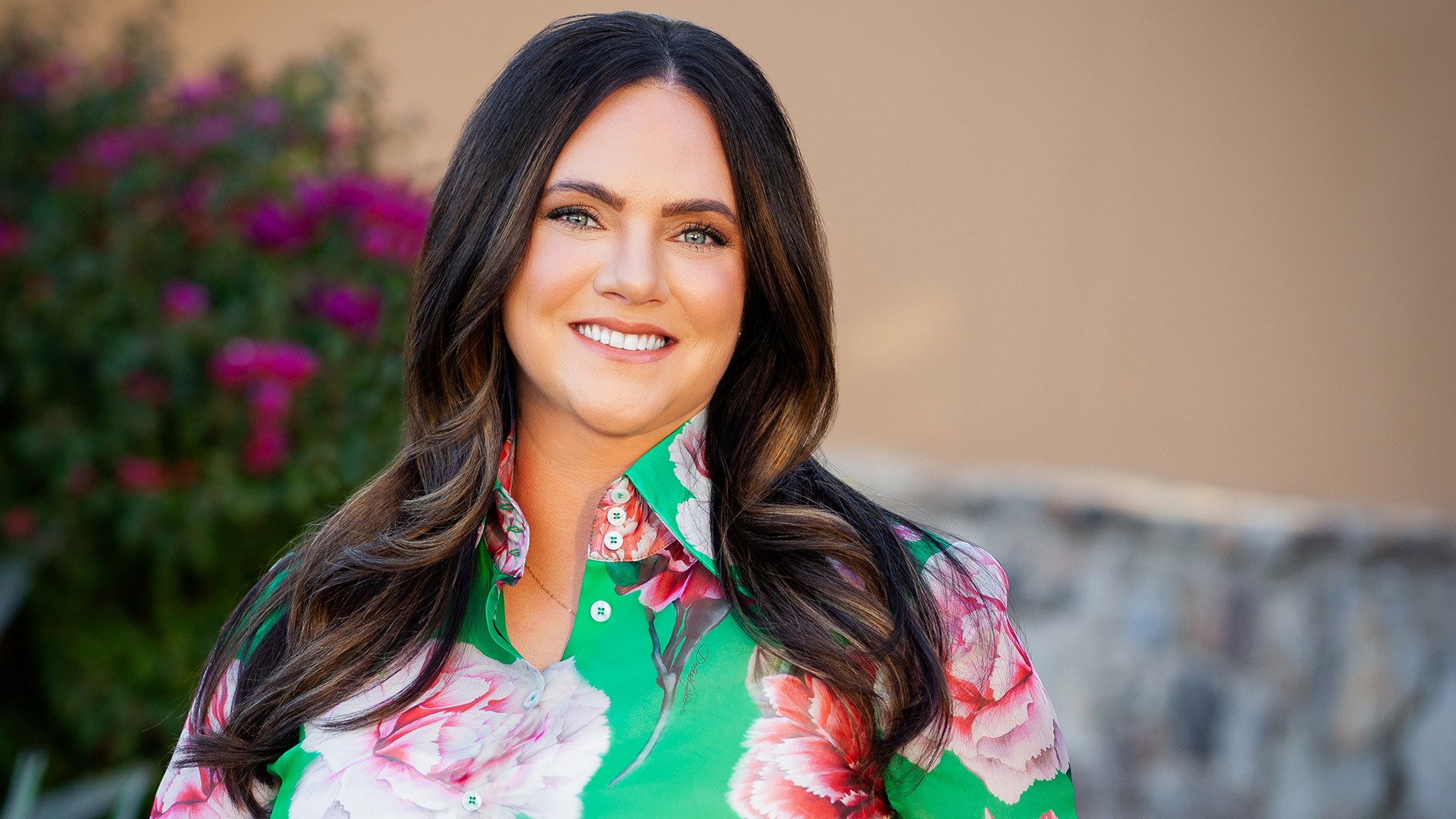Cover Story: Zest for Life

Amanda Garmany talks family, heart health and the power of puzzles
A puzzle sits on the dining room table in Amanda Garmany’s Paradise Valley home. One thousand pieces are waiting to transform into a New England village scene from the 1700s.
“I love puzzles,” Garmany said. “My mother has done them my entire life. I used to get so annoyed with those stupid puzzles on the table. And then probably about 10 or 12 years ago, I don’t know what it was, I just started doing a puzzle.”
It’s a pattern Garmany has followed before — not appreciating the family plan and then coming around to follow it herself. Whether it was where she lived or how she worked, it turns out that family maybe knows best.

Garmany grew up a self-described “unicorn,” a native Arizonan born at Mesa Lutheran Hospital and raised in the East Valley. Her parents met in Mazatlan when her mom — an ASU gymnast and education major on spring break — met her dad, who was from a small Mexican village nearby. He moved to Arizona when they got engaged.
“My parents weren’t wealthy. My mother was a teacher and my father was a construction worker. We never went without, but we didn’t have luxuries,” Garmany said. It was a fun, busy childhood full of activities. Garmany was a competitive dancer, played tennis, rode horses and was a cheerleader. The family frequently traveled to Mexico to visit her father’s family and to the East Coast to visit her mother’s.
As family-oriented as her childhood was, life in a cute suburban community wasn’t Garmany’s style. “Growing up, I always thought, ‘I hate Arizona. When I go to college, I’m going to go away,’” she said. She researched schools on the East Coast, but her parents couldn’t send her.
“Not that my parents didn’t want to, they just couldn’t afford to,” Garmany said. “So I put myself through college. I think it made me work harder, because if I wanted it, I had to go do it myself.”
And she did. She funded her Arizona State University education by working as a bank teller and a cashier at Home Depot. She taught cheer and gymnastics to elementary students in after-school programs and was paid to take notes in college classes. Best Buy, Pier 1, White House Black Market — Garmany worked at them all.
“I ended up realizing how much I love Arizona,” she said.
After earning her bachelor’s degree in political science, Garmany went to work as a paralegal at a law firm. It wasn’t the right fit. “I realized I could be a great attorney, but I didn’t want to do it,” she said.
Searching for inspiration, Garmany looked in a familiar direction — home. Her mother had been a teacher Garmany’s whole life; perhaps it was something she should consider. She started working on her master’s in education, doing observation hours in an English language learning classroom in Mesa.
“I fell in love with the class,” Garmany said. Suddenly, the puzzle pieces of her life were coming together — Mesa, Spanish, teaching. But there was a critical piece still waiting to be found and fit.
Dana Garmany is the founder and executive chairman of Troon. With decades of experience developing and operating golf courses worldwide, he is one of the most powerful and influential people in golf. He and Amanda met at a dinner party 19 years ago, which each was attending with another date. They kept in touch and became many things to each other over the years.

“Friendly acquaintances, friends, good friends, best friends, and then we both ended up being single years later,” Amanda said. “I couldn’t tell you our first date because we would meet for coffee every once in a while or a glass of wine just to catch up.”
Eventually, when they were both single, they started dating.
Fast-forward to when Garmany was volunteering in that ELL classroom in Mesa. She married Dana during that time and, with so much going on, chose to step away from her graduate program.
Dana suggested that she volunteer in class instead. That way, she could write her own schedule and travel with him on business. “So I stayed in that classroom and used my Spanish,” Garmany said. Then the pandemic came.
“COVID hit and the schools shut down. And then this year, with Heart Ball, I told the teacher, who I’ve been with for the last 10 years, I’ll come back next January,” Garmany said.
As chair of this year’s Heart Ball, Garmany’s mind is laser-focused on supporting the American Heart Association’s vital work. She joined the Heart Ball Committee in 2015 and is prepared for the responsibilities ahead.
“I knew what I was getting into with Heart Ball,” she said. “I’ve watched friends chair over the years, and I was a vice-chair for Kristine Thompson. Then I ended up becoming the chair-elect the following year.”
Add an additional learning year due to the COVID shutdown and it’s clear that Garmany is ready for the ball. “At this point, I’ve got this down,” she said.
Years ago, she and Dana received astute advice from a local friend who is very philanthropic. There are so many great causes, he said, you have to pick a handful that are your passion.
For Garmany, heart health ticks that box, hitting close to home.
“My mother’s side of the family has very low resting heart rates,” she said. So low, her mother would periodically pass out. “I was her emergency contact, and she would faint and hit her head at school. They’d have to rush her to the hospital,” Garmany said.
Bradycardia, or low resting heart rate, can be a serious problem if the heart can’t pump enough blood to the body. That was the case for Garmany’s mom, who had a pacemaker installed six years ago. “She’s feeling better. It has made a night-and-day difference,” Garmany said.

A P.E. teacher, Garmany’s mother is fit, so many people are surprised to hear that she was a candidate for heart disease. It’s the kind of a misconception that Garmany wants to correct. “There are so many people who think it’s a man’s disease, but heart disease affects women just as much. It’s the number-one killer of both men and women in this country,” she said.
Every year, the Heart Ball chair comes up with her own mission. “Obviously, it’s on heart disease, but what is it that is impactful to you or that you want to raise awareness toward?” Garmany said. Again, she put the pieces together — Arizona, education, family — to create her platform: “Hope for the Future.”
With her background in education, Garmany knows that getting to children is critical. So she is working to take the Heart Ball’s efforts beyond the ballroom to deliver important messages about heart health where they are needed.
Garmany cites a recent study that found as much as a 14-year difference in life expectancy depending on where in the Valley someone lives. “Your ZIP code shouldn’t determine how long you live,” Garmany said. So she is making efforts to target messaging to children in order to change habits while they are young.
“If you’re obese as a child, the likelihood of being obese your whole life is incredibly high,” Garmany said. “I need to drop a few pounds myself, but I look around this country, and obesity is rampant. There are so many things that obesity contributes to — heart disease, high cholesterol, hypertension, diabetes. We need to communicate that.”
Another way that she and Dana are connecting heart health and kids is by donating CPR kits to local high schools so Arizona students can learn this life-saving procedure. “I really want to make a lasting impact, not just a one-and-done,” Garmany said of her Heart Ball efforts this year.

Hence her “Hope for the Future” platform. Not a bad message for a hometown girl who worked her way through college and is now in a position to give back to the community in a meaningful way.
In fact, maybe her humble start makes her a little more in touch with her philanthropy. “I do think that I get it a little bit more than someone who grew up with more advantages,” Garmany said. “When I was in high school, I volunteered at a center out in Mesa called Paz de Cristo. They had a soup kitchen and a resource center where people could get food boxes or clothing. There were many times my mother’s students came through the line.”
Garmany hasn’t forgotten her roots. She stays close to her family and is looking forward to returning to that Mesa classroom next year. But she also loves her life with Dana. “We spend a lot of time in France, particularly Antibes. We love it,” she said. “We also love good food, going to concerts and hanging out with our dogs.”
It’s a lovely life filled with family, friends, travel and the joys of giving back. And when the stress of chairing the American Heart Association’s signature gala gets to be a little too much, you can find Garmany at her dining room table.
“If I’m getting wound up and anxious, I’ll go play with my puzzle for a little bit. That’s my little stress reliever,” she said.
Save the Date
63rd Annual Phoenix Heart Ball
Nov. 19, 2022
phoenixheartball.heart.org
Heart Health in Maricopa County
It’s an unfortunate fact. When it comes to life expectancy, the average person born in South Phoenix can expect to live 14 years fewer than the average person born in North Scottsdale. Lack of access to quality healthcare, housing, jobs and healthy food perpetuate health inequities throughout Maricopa County.
The American Heart Association has developed a list of policy, system and environmental change opportunities to level the playing field. Its community impact priority issues are:
- Blood pressure control
- Food service delivery
- Culturally relevant nutrition education
- Tobacco control

